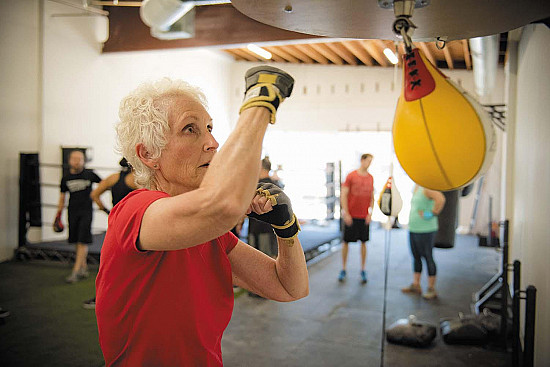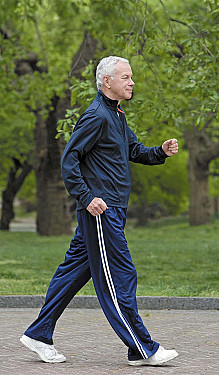Calisthenics: An effective, low-frills way to stay fit
- Reviewed by Howard E. LeWine, MD, Chief Medical Editor, Harvard Health Publishing; Editorial Advisory Board Member, Harvard Health Publishing

You might not hear the term calisthenics used often by the fitness crowd these days, but this form of classic bodyweight exercise is timeless. Calisthenics can provide an excellent, well-rounded workout — with no equipment required. Learn about the many benefits of calisthenics and how to get started with a sample workout.
What are calisthenics?
Calisthenics is a form of strength training that uses your body weight as a form of resistance to perform full-body exercises. Fitness experts regard calisthenics as an effective way to keep in shape that can help improve strength, endurance, flexibility, and coordination.
Push-ups, sit-ups, and jumping jacks are all calisthenics exercises that you may have been doing since gym class as a kid. Today, popular calisthenics exercises like squats, chin-ups, burpees, and planks have been added to the mix. Calisthenics exercises can range from easy to hard and can be modified as needed to meet your fitness level.
Benefits of calisthenics
Calisthenics has been practiced since the time of the ancient Greeks. This type of exercise offers multiple benefits. Here are a few:
Convenience: Calisthenics became one of the most popular exercises during the COVID-19 pandemic. The exercises can be done anywhere and anytime. You can do these exercises when it's convenient for you, where it's convenient for you, and without any special equipment. Plus, it's free.
Adaptability: Body-weight exercises can be tailored to fit your fitness level, whether you're just starting out or are already an athlete. As you get stronger, you'll be able to complete more repetitions of the exercise, or incorporate modifications such as pulses or isometric holds to challenge the muscles.
Efficiency: Even smaller amounts of body-weight exercise can yield positive results. In one study, a routine of eight simple lower-body exercises — such as squats, knee lifts, and heel raises — led to a 15% increase in muscle strength and power after 10 months.
Effectiveness: Body-weight training is highly effective, which is why both the military and elite gymnasts use it to achieve results. Research shows that body-weight exercises can build muscle effectively without the need for external weights. Studies also show calisthenics can increase aerobic capacity, muscle endurance (especially in the core), and flexibility.
Getting started with calisthenics
Getting started with calisthenics is straightforward since you don't need equipment or a gym. All you need is some space where you can safely do the exercises. This can be in your own home if you have a flat surface with enough space to perform the exercises.
Having a repertoire of go-to exercises that are easy to do can also make starting a calisthenics program easier. You can modify these exercises to become more challenging as you develop greater strength and stamina.
Before starting any new exercise program, discuss your goals and plans with your doctor, especially if you have a medical condition such as heart disease, diabetes, arthritis, or osteoporosis.
To get the best results from your calisthenics program, keep these tips in mind:
- Warm up properly. Give yourself five to 10 minutes to warm up before a workout. This allows your body to prepare for exercise by providing more oxygen to your muscles, lubricating your joints, and increasing your range of motion.
- Build up gradually. Taking on too much too soon can lead to injuries. As you gain strength, you can gradually add repetitions, sets, and additional exercises.
- Focus on form. As with all exercises, good form will ensure that you get the most benefits and will help you avoid injuries.
- Don't lock your joints. When straightening out your legs and arms, always leave a slight bend in your knees and elbows.
- Work in a pain-free range of motion. When moving your arms or legs, stick with a range that feels comfortable.
- Let muscles recover. The American College of Sports Medicine recommends only two or three complete strength workouts a week; consider giving yourself a day off in between.
- Keep moves slow and controlled, and breathe throughout. Blood pressure rises if you hold your breath during resistance exercises.
Sample calisthenics workout
You can try the exercises below as part of a calisthenics routine. When you are training for strength, aim for eight to 12 repetitions, or reps. If you cannot do all the reps at first, just do what you can, and then gradually increase reps as you improve. Beginners can start with one set of reps, working up to three sets as you develop strength. Rest 30 to 90 seconds between sets.
Knee lift (warm-up exercise)

Starting position: Stand up straight with your feet together.
Movement: Lift your right knee as high as is comfortable, touching both hands to the knee. Lower your leg, and then repeat with your left knee. This is one rep.
Half squat

Starting position: Stand with your feet shoulder-width apart and your arms at your sides.
Movement: Slowly bend your hips and knees, lowering your buttocks about eight inches, as if you're sitting back in a chair. Let your arms swing forward to help you balance. Keep your spine neutral. Hold. Slowly return to the starting position.
Kneeling push-up

Starting position: Kneel on all fours with your hands shoulder-width apart. Walk your hands forward and lower your hips so your body is at a 45° angle to the floor and forms a straight line from head to knees.
Movement: Bend your elbows out to the sides and slowly lower your upper body toward the floor until your elbows are bent about 90°. Press against the floor and straighten your arms to return to the starting position.
Make it harder: Lift your knees off the floor and do push-ups supporting yourself on your hands and the toes and balls of your feet.
Side lunge with a knee lift

Starting position: Stand up straight with your feet together and your arms at your sides.
Movement: Step out to the side with your left foot while keeping your right foot in place. As your left foot hits the ground, transfer most of your weight to your left leg, hinge forward at your hips, and bend your left knee, lowering into a lunge. Keep your right leg straight and put your hands on your left thigh for support. Press into your left foot to stand back up, shifting your weight onto your right foot, and raise your left knee to hip level. Get your balance, and then step out with your left leg again for another lunge. Continue for 30 seconds. Repeat the sequence, stepping out to the right for 30 seconds.
Plank with a knee drop

Starting position: Kneel on all fours with your hands and knees directly aligned under your shoulders and hips. Extend both legs with your feet flexed and toes touching the floor so that you are balancing on your palms, toes, and balls of your feet, like the top position of a push-up. This is the plank.
Movement: Tighten your abdominal muscles. Lower both knees toward the floor, then extend your legs again to return to the plank position.
About the Author

Jenette Restivo, Health Writer; Assistant Director for Digital Content Creation and Engagement, Harvard Health Publishing
About the Reviewer

Howard E. LeWine, MD, Chief Medical Editor, Harvard Health Publishing; Editorial Advisory Board Member, Harvard Health Publishing
Disclaimer:
As a service to our readers, Harvard Health Publishing provides access to our library of archived content. Please note the date of last review or update on all articles.
No content on this site, regardless of date, should ever be used as a substitute for direct medical advice from your doctor or other qualified clinician.















